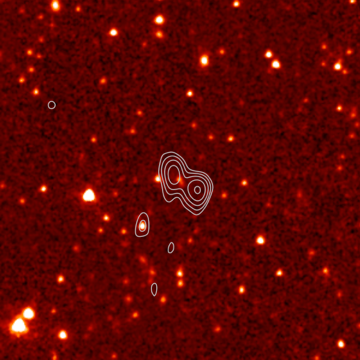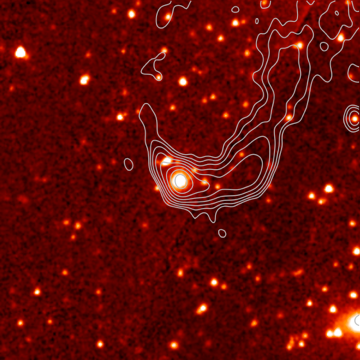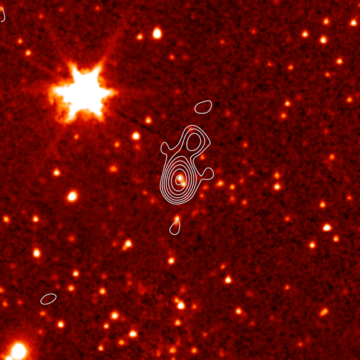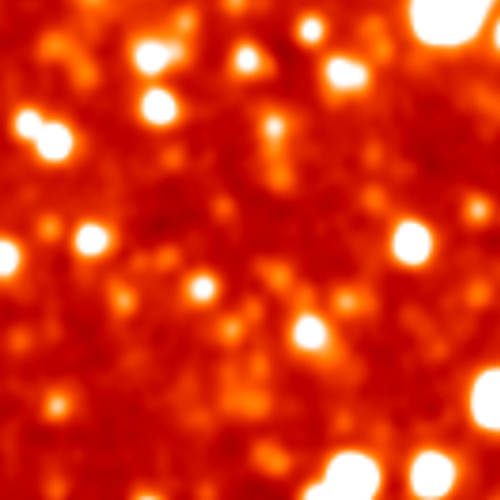Suggested Hashtags
-
 by
vrooje
admin, scientist
by
vrooje
admin, scientist
@stasmanian has compiled a list of possible hashtags to use when commenting on images here. There may be more that will come up later, but in the meantime this is a good start:
(Note: some images as examples in subsequent posts.)
A radio source with two oppositely directed symmetric lobes. Sometimes these will be joined together by the outer contours, other times they will appear separate. Often there will be an infrared galaxy somewhere near half way between the lobes. These are the most powerful black hole eruptions in the Universe, technically known to astronomers as Fanaroff-Riley Type II radio sources, defined as those objects for which the distance between the places of brightest radio emission is more than half the size of the entire radio source. They are sometimes called “edge-brightened” sources. [Examples: Cygnus A, 3C 173.1]
A radio source with symmetric plumes pointing in opposite directions. The plumes become dimmer with distance from the centre of the radio source. These are the less powerful cousins of #hourglass radio sources, and are known to astronomers by the catchy name of Fanaroff-Riley Type I radio sources, defined as objects for which the distance between the places of brightest radio emission is less than half the size of the entire radio source. These are sometimes called “edge-darkened” sources. [Example: 3C 31]
Hybrid radio sources are a rare class of objects where one side is a #hourglass-shaped, and the other looks like a #plume. These are very interesting because they give us vital clues about how the radio sources interact with inter-galactic gas through which they are moving.
Bent sources are created when #hourglass or #plumes radio galaxies get bent away from a straight line as they move through intergalactic gas. It’s a bit like having your hair swept back by the wind while riding a bicycle. These are sometimes called “wide-angled tail” (WAT) sources. Occasionally the optical/infrared galaxy does not show any radio emission from its core (where the black hole is), but instead the emission starts at some distance from the black hole, and is symmetric on both sides. [Example: 3C 465]
A radio source that looks like a tadpole. Typically it will consist of a bright compact region which gradually fades away into a tail. These are probably highly #bent radio sources. [Examples: 4C35.40, 3C 83.1]
A radio source consisting of two or (rarely) more components, with the brightest being at one edge of the source and coinciding with the infrared galaxy. It looks similar to a #headTail source, but the radio emission is clumpy rather than smooth outside the core. These are most likely #hourglass radio sources in which one side of the radio source (the one we can see) points almost directly towards the Earth, while the other side is invisible because it is travelling very fast in a direction away from us. This effect is known as Doppler boosting, and it is a consequence of the jets in radio sources travelling at close to the speed of light. [Example IC 310]
These objects look like a mixture of the #hourglass and #plumes shapes. They will typically consist of two connected blobs (just like #hourglass), but each of these blobs will look like a #plume. [Example: 3C 171]
Radio brightness declines gradually away from the centre of the radio source, more or less equally in all directions. The centre of the radio source coincides with an infrared galaxy. In some cases this could be a nearby spiral galaxy whose radio emission covers over all of its optical/infrared extent. [Example: 3C 84].
A radio source without an infrared host galaxy. These are often faint, and are thought to be created by regions of tenuous intergalactic gas being overrun and excited by shock waves. These sources are invariably found in clusters of galaxies, so there may be lots of infrared sources around, but usually not in a place that makes them look like they are the origin of the radio source.
#groupOfBlackHoles or #BHgroup
A bunch of radio source in close proximity. Black holes live in galaxies, and galaxies are real socialites: they are mostly found in groups rather than on their own. Finding many black holes “going off” at the same time both makes for a pretty picture, and also helps us understand just what triggers these black hole eruptions.
Diffuse radio emission scattered throughout the image. There is an infrared galaxy at the centre (if not, it is a #relic).
When it all looks like one big mess…
Posted
-
 by
vrooje
admin, scientist
by
vrooje
admin, scientist
Note: I can't do the nifty slider thing in these posts, so I'll show examples side by side (or vertically, depending on your window size).
Examples of #hourglass :






Posted
-
 by
vrooje
admin, scientist
by
vrooje
admin, scientist
Examples for #plume :




Posted
-
 by
vrooje
admin, scientist
by
vrooje
admin, scientist
Examples for #hybrid :




Posted
-
 by
vrooje
admin, scientist
by
vrooje
admin, scientist
Examples for #bent :


Posted
-
 by
vrooje
admin, scientist
by
vrooje
admin, scientist
Examples for #headTail :


Posted
-
 by
vrooje
admin, scientist
by
vrooje
admin, scientist
Examples for #coreJet :




Posted
-
what about #noinfrared for when an object has no infrared emission?
Posted
-
 by
ivywong
scientist, admin
by
ivywong
scientist, admin
suggest #artefact for the processing stripes and lines that are seen in some images
Posted
-
 by
42jkb
scientist, admin
by
42jkb
scientist, admin
Use #star if there is an IR source that is a star and near the radio source.
Posted
-
 by
mini.mintaka
scientist
by
mini.mintaka
scientist
#compact for radio point sources!
Posted
-
#doublelobe for galaxies with lobes further apart than hourglass
example:

Posted
-
 by
raynorris
scientist
by
raynorris
scientist
I suggest #overedge for a source which clearly goes over the edge of the displayed image, so you're not seeing all of it
Posted
-
 by
enno.middelberg
scientist, translator
by
enno.middelberg
scientist, translator
We should also use #triple for a core and two jets.
Posted
-
 by
vrooje
admin, scientist
by
vrooje
admin, scientist
I have also just suggested #missingIR for the rare case of data where the IR image seems to be missing entirely, e.g. ARG0002pqm .
Posted
-
 by
enno.middelberg
scientist, translator
by
enno.middelberg
scientist, translator
The definition of #relic is a bit unfortunate and is ambiguous with #ifrs. Relics are large and have no clear centre (#messy maybe), but IFRS are mostly "normal" radio objects.
Posted
-
 by
enno.middelberg
scientist, translator
in response to vrooje's comment.
by
enno.middelberg
scientist, translator
in response to vrooje's comment.
In this one the IR is there, it's just vastly over-exposed. Take a look at the top of the image, where one can see a little bit of background.
Posted
-
#IFRS short for infrared radio source, a type of radio galaxy at a redshift of z= 2.0
Often large galaxies with no infrared emission are these.
Posted
-
 by
JeanTate
in response to planetaryscience's comment.
by
JeanTate
in response to planetaryscience's comment.
Actually, according to enno.middelberg scientist, it stands for Infrared-Faint Radio Source. See the What are Infrared-Faint Radio Sources? thread.
Posted
-
Oh, I kept not noticing faint, then. Sorry 😛
infrared-FAINT radio source. 😉
Posted
-
 by
firejuggler
by
firejuggler
Could we get a #strange or #notable tag for the one we find ... strange or notable?
Posted
-
 by
ivywong
scientist, admin
by
ivywong
scientist, admin
***Note this is just my personal opinion and it might be a good idea to get more than just my opinion.....
I noticed that many people are starting their own collections of "strange"/"notable" objects but in terms of hashtags, it's not so descriptive (ie. different people might have different strangeness thresholds) so I think that it might be better to keep them as collections rather than start a hashtags. What does everyone else think?
Posted
-
 by
firejuggler
by
firejuggler
case in point this one here . I tagged it as massive, but the radio is very very strange to me. What tag should I put on this kind? over edge? multiple? #strange?
Posted
-
 by
ivywong
scientist, admin
by
ivywong
scientist, admin
Yes, it is definitely #overedge and it is massive. 😃 It is quite a nearby radio galaxy. Check out this optical SDSS image of it: http//cas.sdss.org/dr6/en/tools/chart/chart.asp?ra=162.28&dec=38.80827291 (The galaxy itself looks quite boring doesn't it relative to the massive jet... 😉 )
Not sure if you saw the image I posted of the jet from Centaurus A (nearest radio galaxy) superposed on the night sky with the full moon. Check out how massive it'd look on the sky if our eyes could see it:
http://blog.galaxyzoo.org/2013/12/17/welcome-to-radio-galaxy-zoo/Jet structure and the physical mechanisms required to generate them is a big industry in black hole astrophysics 😃
Posted
-
 by
DocR
scientist
by
DocR
scientist
Use #giant for sources that are much bigger than the image presented by RGZoo . For super-zooers, you have to go out of Zoo to find these. See http://radiotalk.galaxyzoo.org/#/boards/BRG0000003/discussions/DRG00001mg
Posted
-
 by
zutopian
by
zutopian
bent-tailed radio sources :
http://radiotalk.galaxyzoo.org/#/boards/BRG0000003/discussions/DRG00006b2
Posted
-
 by
gavinrider
by
gavinrider
I haven't been applying many hashtags up to now because I am not familiar with all the classifications you use. Is it helpful for us to give our work hashtags even if we don't know all the proper classifications? How do you use these hashtags? Is it a problem if we DON'T give our observations hashtag labels?
A bit more guidance on this, and perhaps a hashtag glossary to refer to in the spotter's guide, would be really helpful for the "enthusiastic novices" amongst us!
Posted
-
 by
JeanTate
by
JeanTate
Welcome to RGZ, gavinrider! 😃
I don't think the lack of hashtags will make much difference to the main research done by the core team of astronomers (but perhaps one could chime in?). For independent research done by enthusiastic zooites, or research beyond the main project (done by professionals, be they astronomers or social scientists), hashtags would likely be very interesting, important even.
A hashtag glossary - with good examples - was begun in Talk, I think, near the start of this project; however, the, um, peculiarities of Talk meant that it was quickly abandoned.
To get an idea of what the main hashtags refer to, you could click on any in the "Popular hashtags" part (bottom left), and have a look at what others have used them for (be sure to right-click on the links that come up in the Search page, and choose 'open link in a new tab' (or whatever equivalent your browser offers), otherwise you won't be able to go Back!). Alternatively, you could choose a super-zooite - such as Dolorous Edd or antikodon - and see what they used the various hashtags for.
Happy hunting! 😄
Posted
-
 by
gavinrider
by
gavinrider
Thanks Jean. I see a list of hashtags but there is no description of what they refer to so it does not really help me to choose the right one. some are downright confusing - like what is a "WAT" and a "NAT"??? These tags crop up all the time but I cannot decipher what they mean from looking at the images they are posted for!
Posted
-
 by
JeanTate
in response to gavinrider's comment.
by
JeanTate
in response to gavinrider's comment.
Hi gavinrider.
Yeah, it can be downright confusing! And with Talk's Search being unreliable, and an inability to point to (provide a URL/link to) individual posts, it's not easy to make much headway on your own.
For some background - fun reading if nothing else - there are the RGZ blog posts in the GZ blog; here is a link to them.
WAT = wide-angled tail; the two 'tails' from a radio source (host) are not back-to-back, but are at an angle, a 'wide angle' (sorta >~100 degrees, I guess).
NAT = narrow-angled tail; ditto, but with 'narrow'.I'll have a go at posting some links, together with a brief explanation, of some of the more common ones (but not today, sorry).
Posted
-
 by
ivywong
scientist, admin
by
ivywong
scientist, admin
Hi @gavinrider,
Here is the list of suggested hashtags: http://radiotalk.galaxyzoo.org/#/boards/BRG0000001/discussions/DRG000000dAlso, here are 2 blog posts where you can find more information on "tailed radio galaxies":
http://blog.galaxyzoo.org/2014/01/16/more-information-on-tailed-radio-galaxies-part-1/
http://blog.galaxyzoo.org/2014/01/17/more-information-on-tailed-radio-galaxies-part-2/As well as 2 blog posts on the "curious lives of radio galaxies":
http://blog.galaxyzoo.org/2014/02/03/the-curious-lives-of-radio-galaxies-part-one/
http://blog.galaxyzoo.org/2014/02/04/the-curious-lives-of-radio-galaxies-part-two/I hope these are helpful
Posted
-
 by
gavinrider
by
gavinrider
Thanks Ivy. Very interesting material.
However, for those of us who are not immersed in this subject full-time and able to carry all the classifications around in our heads, it would be nice if the site could have a glossary table made available for the amateurs among us to refer to while we are classifying the objects. The spotter's guide really needs updating to include this information as the material currently there is not very useful.
Posted
-
 by
ivywong
scientist, admin
by
ivywong
scientist, admin
Thank you very much @gavinrider for your suggestions !
The purpose of the spotter's guide is to provide a sample of radio morphologies upon which the users can build up their intuition for the variation in radio morphologies. We kept the Spotter's Guide at its simplest and current form in order so that we do not intimidate new participants with too much information. As this topic involves some fairly detailed jargon, previous alpha/beta/gamma testing informed us that the majority of the users do not need to know the exact jargon for them to identify the radio sources and host galaxies successfully.
The hashtag classifications are not compulsory so they are not at the forefront of the project for the same reason as keeping the Spotters Guide fairly simple. However, we're very glad to hear that you find the glossary table useful so perhaps you can keep this glossary in a separate browser tab/window while you're classifying at the same time.
It has been quite tricky for us to balance the need for keeping the project simple in order to not intimidate with the wealth of information versus providing more information for our superZooites. So our current solution is to keep up this conversation in RGZTalk in order for us to cater to all our participants' needs.
Thanks again for your suggestions.
Posted
-
 by
gavinrider
by
gavinrider
Hi Ivy
Perhaps I don't understand how our "classification" input is being used. If it is worth having hashtags at all then it is clearly worth us using them - and for that we have to understand what they refer to and we have to use the tags correctly.I don't find a simple list of hashtag names particularly useful if I cannot identify what a "WAT" or a "NAT" is without having to read lots of (admittedly very interesting) blog content and hopefully coming across it somewhere almost by chance. I don't believe that adding a glossary of terms for these hashtags would be intimidating to anyone. A table listing the hashtags that the scientists are most interested in, with brief descriptions of what they mean and with one or two example images showing what those kinds of sources typically look like would just be valuable reference material. People who don't want to use the hashtags would not need to look at it!
Posted
-
 by
ivywong
scientist, admin
by
ivywong
scientist, admin
Hi @gavinrider,
Noted. Thanks for your suggestions.
The main classifications we require from our participants is the classification of one (or multiple) radio components into radio sources and then the identification of their respective host galaxies.
You have made some good points so we'll set up a simple table as you suggested with attached examples of the various common types of extreme radio source morphologies. Stay tuned for the updated list.
cheers,
IvyPosted
-
 by
ivywong
scientist, admin
by
ivywong
scientist, admin
Summary list of examples for various commonly-used hashtags:
(it's difficult to format this into a pictorial table but these links to example should be useful)#compact and #artefact: Example of a compact source subject contaminated by processing artefacts
#star: Example of a source contaminated by a foreground star
#hourglass: Example of an hourglass source
#doublelobe: Example of a doublelobe source--a more extended hourglass
#triple: Example of a triple source--similar to doublelobe but with core emission
#corejet: Example of a corejet-- typically shown as a compact core with a one-sided jet
#bent: Example of a bent jet-- note that these include the categories of wide-angled tails (#wat) or narrow-angled tails (#nat). The difference between a #wat and a #nat is the observed angle of the bent tails
(For more information about #wat and #nat, see http://blog.galaxyzoo.org/2014/01/16/more-information-on-tailed-radio-galaxies-part-1/)
#ifrs: Stands for Infrared Faint Radio Sources. Here is an example of a double lobe with no IR counterpart
#overedge: For massive sources which extend beyond the edge of the field-of-view. Example of a source marked as overedge
Posted
-
 by
DZM
Zooniverse Team
in response to ivywong's comment.
by
DZM
Zooniverse Team
in response to ivywong's comment.
Might it be good to start a new locked thread that contains all of the suggested hashtags from this thread, in this format, in a single locked post? Maybe even just this post, copy-pasted in a more prominent spot, and locked?
Whoever created it (@ivywong ?) could then continue to update it regularly if there are new hashtags that folks should know about.
We could even add a link from the classification interface, if you wanted?
Posted
-
 by
JeanTate
by
JeanTate
For what it's worth, I can't tell the difference between #corejet and #headtail (the latter one of the hashtags in the OP), at least not in the objects I've classified. Also, I rarely use #plume or #plumes. And I use #overedge for sources where there's a lobe/feature that's completely outside the displayed field (not just 'on/near the edge'). To me, many of the examples vrooje posted, on page 1, are ambiguous, particularly those which seem to require a firm ID of an optical/IR host (not to mention when the core seems offset from the host!).
I have never - as far as I remember - used #relic, #halo, #bhgroup, #hourglassplume, or even #diffuse. And I spell it #artifact 😛
As I understand it, #hybrids are rare, and - to me - not that easy to be certain of; it might be helpful if any guide also gives some indiciation of relative rarity. For example, not listed is #x-shaped or #s-shaped, yet these are also quite rare (and just as interesting as hybrids, I think).
Finally, what about #compact? These sources sure are common, and boring, and more than once an astronomer has suggested to not waste time using this hashtag. Fair enough; but any guide should surely include mention of this fact, right?
Posted
-
 by
ivywong
scientist, admin
in response to DZM's comment.
by
ivywong
scientist, admin
in response to DZM's comment.
Hi @DZM,
I think the this thread is fine the way it is at the moment as it only spans 4 pages but if you think that the community would like this post copy & pasted in a more prominent and locked position then let's do that. As you can see from @JeanTate's comment, there are many hashtags that have been suggested but not as commonly-used, so that is why I have suggested the 10 which I think is most used (...but that is my personal opinion/experience from my own clicks).
cheers,
IvyPosted
-
 by
ivywong
scientist, admin
in response to JeanTate's comment.
by
ivywong
scientist, admin
in response to JeanTate's comment.
Hi @JeanTate,
I agree that some of the hashtags are not as easy to differentiate and so I do not think that I have used them either (at least in the case of #corejet vs #headtail). I have used #overedge and #bhgroup or even #diffuse on occasions.
In terms of #compact, it is true that this is not super useful at most times but at certain times when the subject is highly marred by processing artefacts, a compact source may be mistaken for a more extended source so that is where I'd use the combination of #artefact (or #artifact is fine too) and #compact.
Does this help?
Posted
-
 by
DZM
Zooniverse Team
in response to ivywong's comment.
by
DZM
Zooniverse Team
in response to ivywong's comment.
It's up to you. 😃 If you think it's alright, fine by me!
Posted
-
 by
Gweilouk
by
Gweilouk
A question if I may. Is the Hashtag #compact used to cover sources that could be either GPS or CSS? Not sure if this is the right place for this post so apologies if it's not.
Paul
Posted
-
 by
JeanTate
in response to Gweilouk's comment.
by
JeanTate
in response to Gweilouk's comment.
Yes.
But I don't think it makes any difference, for this project ... to tell if a radio source is Gigahertz Peaked Spectrum (GPS) or Compact Steep Spectrum (CSS) you need to have observations at at least two different frequencies (preferably more), but we're using FIRST data, which is observations taken at just one frequency (1.4 GHz).
Also, not all #compact sources we identify will be either GPS or CSS; FIRST's resolution is pretty big (~5", from memory), so if a source is distant (say, z>0.5) it can appear compact even though it may be many hundred pc in extent. Further, more local compact sources may actually be 'resolved' in FIRST ('extended'), but still look like a nice bullseye of contours!
Hope this helps, and happy hunting! 😃
Posted
-
 by
mbstone12
in response to enno.middelberg's comment.
by
mbstone12
in response to enno.middelberg's comment.
Do you have an example of #triple? thx
Posted
-
 by
JeanTate
in response to mbstone12's comment.
by
JeanTate
in response to mbstone12's comment.
Here is a good one, and here another.
Sometimes one or more component has contours which overlap with another, for example here and here; sometimes the three are all within at least one contour, e.g. here.
The idea is that there's a central component, the core (which is nearly always at the same position as a galaxy, called the host), and two lobes, one on either side.
Hope this helps, and happy hunting! 😃
Posted